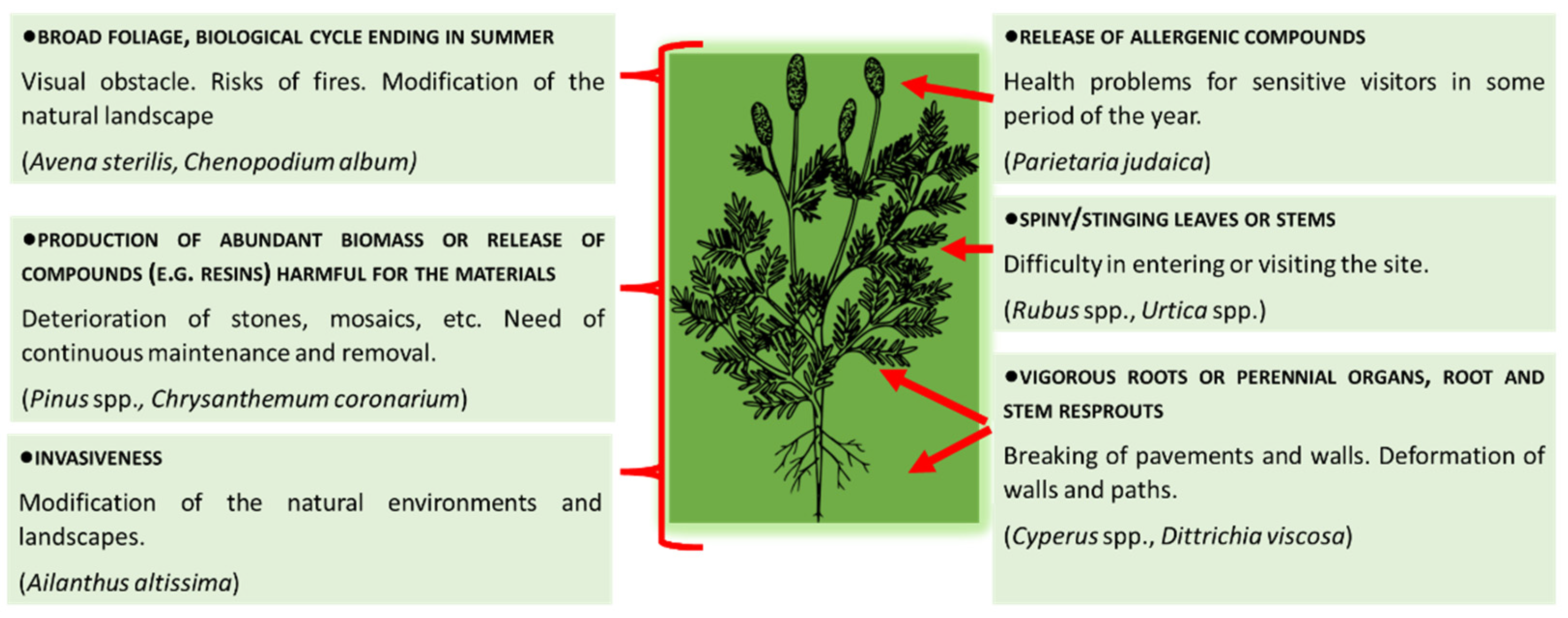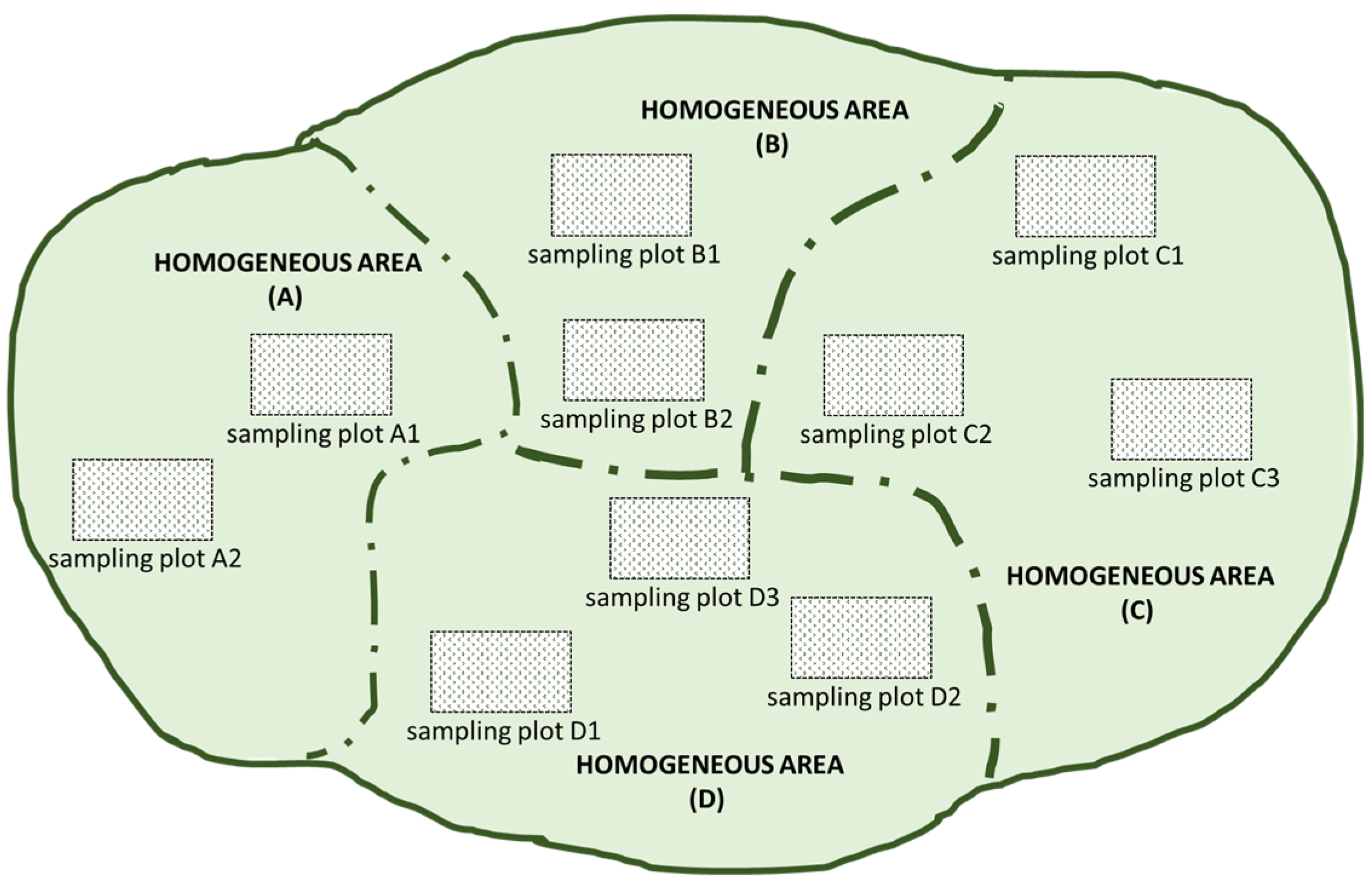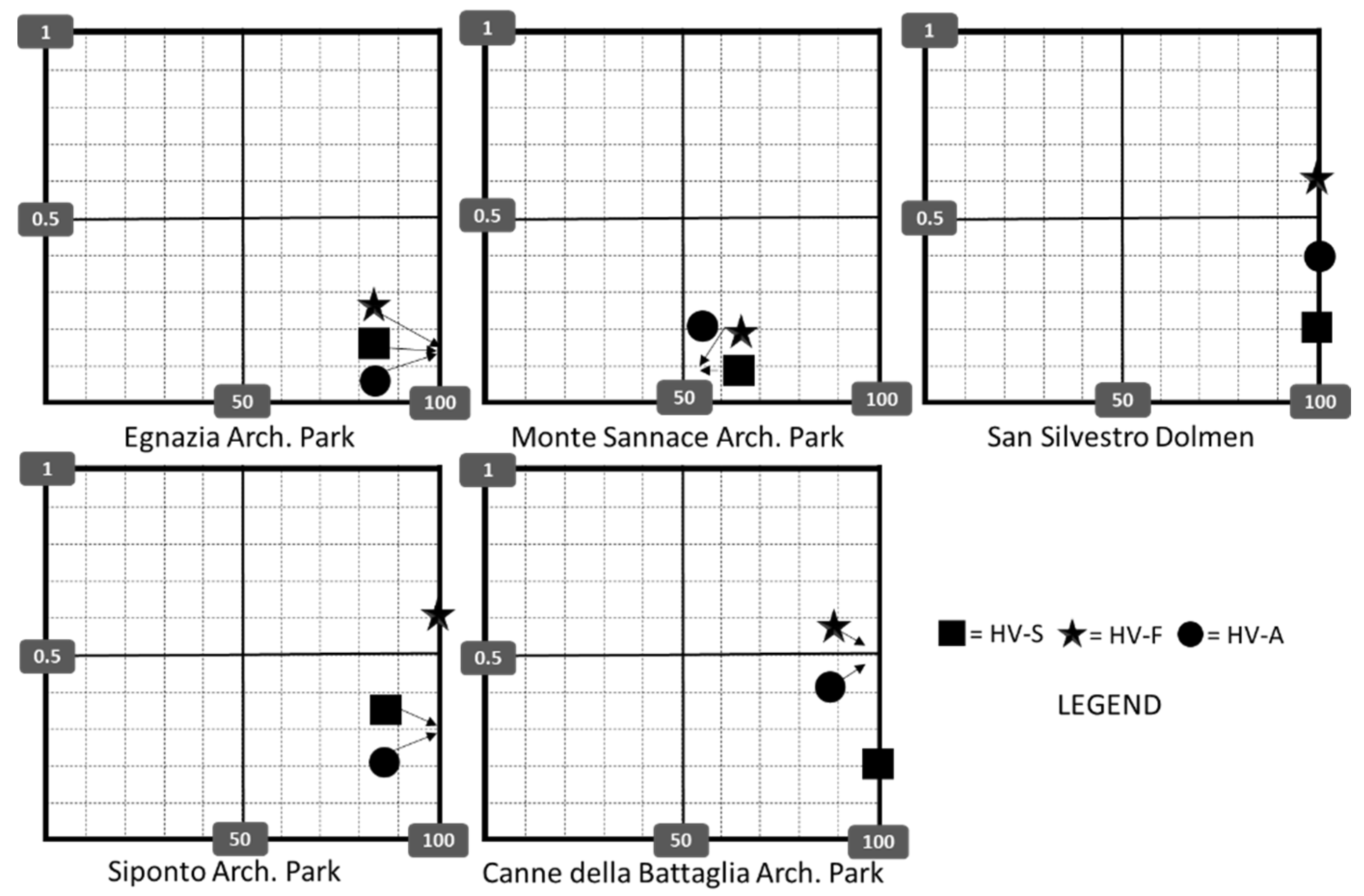Weeds in Non-Agricultural Areas: How to Evaluate the Impact? A Preliminary Case Study in Archaeological Sites
Abstract
1. Introduction
Research Aim
- Quantify the degree of the infestation, in terms of occurring species.
- Quantify the related hazard based on some characteristics of the weed community.
- Propose indexes capable of providing synthetic and comparable information on the hazard to which a site is exposed.
2. Materials and Methods
2.1. Archaeological Sites
2.2. Procedure Followed
- Homogeneous areas selection for surveying.
- Description of the structure of the weed community.
- Weed weighting.
- Definition of Hazard Values.
- Site evaluation based on weed community impact.
2.3. Homogeneous Areas Selection for Surveying
2.4. Description of the Structure of the Weed Community
- Total cover (Tc), as the sum of the covers of every single species (Sc) to have first information about how the site was infested. The value can exceed 100% as plants can grow on several layers.
- Total cover of all species grouped according to Raunkiaer’s plant life form classification [18], namely Therophytes, Hemicryptophytes, Chamaephytes, Phanerophytes, Geophytes. This procedure gave useful information about the type of vegetation occurring in the site; for example, if it was dominated by herbaceous plants, trees, or shrubs, or also by perennial or annual plants.
- Species richness (Sr), that is, the total number of taxa found on the site. This value had to be evaluated together with the Shannon Index described below.
- Shannon Diversity Index (Sh) was calculated to detect if the community was dominated by only a few species. In surveys conducted for several years, with the same number of species, a lower value of the index can be an indication of shifting toward a population dominated by only a few species.
2.5. Weed Weighting
- Structural hazards.
- General hazards.
2.5.1. Structural Hazards in the Strict Sense
2.5.2. General Hazards
- The hazard of a fire occurring, a very common cause of damage under Mediterranean climate conditions. For this aspect, species were evaluated as potentially “undesirable” both if characterized by abundant production of biomass (under the conditions of the studied area), and if plants show dried burnable parts at the beginning of the dry season (end of spring–beginning of summer).
- The hazard for the health of visitors due to the release of allergenic pollens. The list of allergenic species was referred to Ferrero et al. [22]; in other geographical areas with different vegetation, it can be referred to as a pertinent source of information.
2.6. Definition of Hazard Values
2.6.1. Hazard Value on Structures
2.6.2. General Hazard Values
- Hazard Value due to fire occurring (HV-F).
- Hazard Value due to release of allergenic compounds (HV-A).
2.7. Site Evaluation Based on Weed Community Impact
- Quadrants with Low infestation and High hazard (LH) or High infestation and Low hazard (HL). They represent “conditions of attention”. In the first condition, although unwanted flora occurs, it has low levels of coverage; therefore, priority could be given to other sites for the execution of control operations. In the second case, although there is a high infestation, this does not present dangerous characteristics for the damages considered.
- Quadrant with Low infestation and Low hazard (LL). It represents a “safe condition”, as there is a low infestation, and not even potentially harmful.
- Quadrant with High infestation and High hazard. It represents a “condition of priority”, with high infestation and, in addition, potentially harmful. Sites in this condition must have priority in performing control operations.
3. Results
4. Discussion
5. Conclusions
Supplementary Materials
Author Contributions
Funding
Institutional Review Board Statement
Informed Consent Statement
Data Availability Statement
Acknowledgments
Conflicts of Interest
References
- Holzner, W. Concepts, categories and characteristics of weeds. In Biology and Ecology of Weeds; Springer: Dordrecht, The Netherlands, 1982; pp. 3–20. [Google Scholar]
- Godinho, I. Les définitions d’‘adventicee’et de ‘mauvaise herbee’. Weed Res. 1984, 24, 121–125. [Google Scholar] [CrossRef]
- Maillet, J. Constitution et Dynamique des Communautés de Mauvaises Herbes des Vignes de France et des Rizières de Camargue. Ph.D. Thesis, Université de Montpellier, Montpellier, France, 1992. [Google Scholar]
- Swanton, C.J.; Roger, N.; Blackshaw, R.E. Experimental methods for crop–weed competition studies. Weed Sci. 2015, 63, 2–11. [Google Scholar] [CrossRef]
- Benvenuti, S. Weed dynamics in the Mediterranean urban ecosystem: Ecology, biodiversity and management. Weed Res. 2004, 44, 341–354. [Google Scholar] [CrossRef]
- Celesti-Grapow, L.; Blasi, C. The Role of Alien and Native Weeds in the Deterioration of Archaeological Remains in Italy. Weed Technol. 2004, 18, 1508–1513. [Google Scholar]
- Celesti-Grapow, L.; Ricotta, C. Plant invasion as an emerging challenge for the conservation of heritage sites: The spread of ornamental trees on ancient monuments in Rome, Italy. Biol. Invasions 2021, 23, 1191–1206. [Google Scholar] [CrossRef]
- Hanzlik, K.; Gerowitt, B. Methods to conduct and analyse weed surveys in arable farming: A review. Agron Sustain. Dev. 2016, 36, 11. [Google Scholar] [CrossRef]
- Barralis, G. Méthode d’étude des groupements adventices des cultures annuelles; application à la Côte d’Or. In 5. Colloque International sur l’Ecologie et la Biologie des Mauvaise Herbes; Versailles: Dijon, France, 1976. [Google Scholar]
- Braun-Blanquet, J. Plant Sociology; Fuller, G.D., Conrad, G.D., Eds.; Fuller, G.D.; Conrad, G.D., Translators; Reprint of 1983; Koeltz Scientific Books: Koenigstein, Germany, 1932. [Google Scholar]
- Păltinean, R.; Toiu, A.; Wauters, J.N.; Frédérich, M.; Tits, M.; Angenot, L.; Tămaş, M.; Crişan, G. Identification and determination of alkaloids in fumaria species from Romania. Dig. J. Nanomater. Bios. 2013, 8, 817–824. [Google Scholar]
- Parolin, P.; Scotta, M.I.; Bresch, C. Biology of Dittrichia viscosa, a Mediterranean ruderal plant: A review. Phyton-Int. J. Exp. Bot. 2014, 83, 251–262. [Google Scholar]
- Froud-Williams, R.J. Weed competition. In Weed Management Handbook 9; John Wiley & Sons: Hoboken, NJ, USA, 2002; pp. 16–38. [Google Scholar]
- Signorini, A. L’Indice di pericolosità: Un contributo botanico al controllo della vegetazione infestante delle aree monumentali. Inf. Bot. Ital. 1996, 28, 7–13. [Google Scholar]
- Motti, R.; Bonanomi, G.; Stinca, A. Biodeteriogens at a southern Italian heritage site: Analysis and management of vascular flora on the walls of Villa Rufolo. Int. Biodeter. Biodegr. 2021, 162, 105252. [Google Scholar] [CrossRef]
- Van der Maarel, E. Transformation of cover-abundance values in phytosociology and its effects on community similarity. Vegetatio 1979, 39, 97–114. [Google Scholar]
- Lepš, L.; Hadincová, V. How reliable are our vegetation analyses? J. Veg. Sci. 1992, 3, 119–124. [Google Scholar] [CrossRef]
- Raunkiaer, C. The Life Forms of the Plant and Statistical Geography; Clarendon Press: Oxford, UK, 1934. [Google Scholar]
- Mahn, E.G.; Helmecke, K. Effects of herbicide treatment on the structure and functioning of agro-ecosystems. Structural changes in the plant community after the application of herbicides over several years. Agro-Ecosyst. 1979, 5, 159–179. [Google Scholar] [CrossRef]
- Pignatti, S.; Guarino, R.; La Rosa, M. Flora d’Italia; Edagricole: Bologna, Italy, 2018. [Google Scholar]
- Portal to the Flora of Italy. Published on the Internet. Available online: http://dryades.units.it/floritaly/index.php (accessed on 20 March 2022).
- Ferrero, A.; Maggiore, T. Piante Erbacee Allergeniche; FrancoAngeli: Milano, Italy, 2000. [Google Scholar]
- Fracchiolla, M.; Caramia, D.; Lasorella, C.; Montemurro, P. Ground cover management strategies in an Apulian oil-producing olive grove: Agronomic and ecological assessment proposals. Adv. Hortic. Sci. 2013, 27, 44–54. [Google Scholar]
- Fracchiolla, M.; Terzi, M.; D’Amico, F.S.; Tedone, L.; Cazzato, E. Conservation and pastoral value of former arable lands in the agro-pastoral system of the Alta Murgia National Park (Southern Italy). Ital. J. Agron. 2017, 12, 2. [Google Scholar] [CrossRef]
- Fagot, M.; De Cauwer, B.; Beeldens, A.; Boonen, E.; Bulcke, R.; Reheul, D. Weed flora in paved areas in relation to environment, pavement characteristics and weed control. Weed Res. 2011, 51, 650–660. [Google Scholar] [CrossRef]
- Terzi, M.; Barca, E.; Cazzato, E.; D’Amico, F.S.; Lasorella, C.; Fracchiolla, M. Effects of Weed Control Practices on Plant Diversity in a Homogenous Olive-Dominated Landscape (South-East of Italy). Plants 2021, 10, 1090. [Google Scholar] [CrossRef] [PubMed]
- Kudsk, P.; Streibig, J.C. Herbicides—A two-edged sword. Weed Res. 2003, 43, 90–102. [Google Scholar] [CrossRef]
- Orsenigo, S.; Fenu, G.; Bacchetta, G.; Bernardo, L.; Calvia, G.; Citterio, S.; Foggi, B.; Fois, M.; Gangale, C.; Galasso, G.; et al. Global and regional IUCN Red List assessments: 2. Ital. Bot. 2016, 2, 93. [Google Scholar] [CrossRef][Green Version]





| N. | Sites | Acronym | Location | G.C. |
|---|---|---|---|---|
| 1 | Monte Sannace Archaeological Park | MSA | Gioia del Colle (BA) | 40.83° N, 16.96° E |
| 2 | Egnazia Archaeological Park | EGN | Fasano (BR) | 40.88° N, 17.38° E |
| 3 | San Silvestro Dolmen | SSI | Giovinazzo (BA) | 41.15° N, 16.63° E |
| 4 | Siponto Archaeological Park | SIP | Siponto (FG) | 41.60° N, 15.89° E |
| 5 | Canne della Battaglia Archaeological Park | CAB | Barletta (BAT) | 41.28° N, 16.14° E |
| Abbreviations | Extended Terms | Explanation |
|---|---|---|
| HoA | Homogeneous area | Each of the areas into which the site is divided. |
| SaP | Sampling plot | Each of the areas in which the surveying is carried out. |
| Sr | Species richness | Total number of taxa found in the site. |
| Sc | Single species cover | Cover of a single species assigned with the procedure described in Table 3. |
| Tc | Total cover | Sum of the covers of every single species. |
| Sh | Shannon Diversity Index | ) |
| S-HaI G-HaI | Hazard Index (structural) Hazard Index (general) | The Index gives each species a different value (weight) based on its traits and the consequent hazards it can bring. It is referred to structural hazards and calculated following [14] or to other interferences and can assume values equal to 0 (irrelevant) or 1 (undesirable species). |
| HV-S | Hazard Value on Structures | Index calculated to evaluate the hazard magnitude to which the area is exposed. ∑[S-HaIi × (Sci/Tc)]/10 |
| HV-F | Hazard Value due to fire occurring | Indexes calculated to evaluate general hazards. ∑(Sci/Tc) × G-HaIi |
| HV-A | Hazard Value due to release of allergenic compounds |
| Index | Criteria | Midpoints of the Cover Range (%) |
|---|---|---|
| 5 |  Any number of individuals covering 75–100% of the area | 87.5 |
| 4 |  Any number of individuals covering 50–75% of the area | 62.5 |
| 3 |  Any number of individuals covering 25–50% of the area | 37.5 |
| 2 |  Very numerous or covering at least 5–25% of the area | 17.5 |
| 1 |  Plentiful but of small cover value or higher cover with few plants. In any case, cover < 5% | 5.0 |
| + |  Sparsely or very sparsely occurring, cover very small | 0.1 |
| Cover of the Species (%) | Sites | ||||
|---|---|---|---|---|---|
| EGN | MSA | SSI | SIP | CAB | |
| Total | 142.6 | 53.7 | 107.0 | 166.4 | 149.9 |
| Therophytes | 137.3 | 49.6 | 103.8 | 127.2 | 107.7 |
| Hemicryptophytes | 5.2 | 3.9 | 3.2 | 39.2 | 42.2 |
| Geophytes | 0.0 | 0.1 | 0.0 | 0.1 | 0.0 |
| Chamaephytes | 0.0 | 0.1 | 0.0 | 0.0 | 0.0 |
| Phanerophytes | 0.1 | 0.0 | 0.0 | 0.0 | 0.0 |
| Richness | 32 | 27 | 37 | 30 | 23 |
| Shannon Index | 1.4 | 1.4 | 2.0 | 1.9 | 1.8 |
| Infestation Hazard Values | Sites | ||||
|---|---|---|---|---|---|
| EGN | MSA | SSI | SIP | CAB | |
| Structures (HV-S) | 0.2 | 0.1 | 0.2 | 0.3 | 0.2 |
| General hazards Likelihood of a fire occurring (HV-F) | 0.2 | 0.1 | 0.6 | 0.6 | 0.5 |
| Release of allergenic compounds (HV-A) | 0.2 | 0.2 | 0.4 | 0.3 | 0.5 |
Publisher’s Note: MDPI stays neutral with regard to jurisdictional claims in published maps and institutional affiliations. |
© 2022 by the authors. Licensee MDPI, Basel, Switzerland. This article is an open access article distributed under the terms and conditions of the Creative Commons Attribution (CC BY) license (https://creativecommons.org/licenses/by/4.0/).
Share and Cite
Fracchiolla, M.; Lasorella, C.; Cazzato, E.; Vurro, M. Weeds in Non-Agricultural Areas: How to Evaluate the Impact? A Preliminary Case Study in Archaeological Sites. Agronomy 2022, 12, 1079. https://doi.org/10.3390/agronomy12051079
Fracchiolla M, Lasorella C, Cazzato E, Vurro M. Weeds in Non-Agricultural Areas: How to Evaluate the Impact? A Preliminary Case Study in Archaeological Sites. Agronomy. 2022; 12(5):1079. https://doi.org/10.3390/agronomy12051079
Chicago/Turabian StyleFracchiolla, Mariano, Cesare Lasorella, Eugenio Cazzato, and Maurizio Vurro. 2022. "Weeds in Non-Agricultural Areas: How to Evaluate the Impact? A Preliminary Case Study in Archaeological Sites" Agronomy 12, no. 5: 1079. https://doi.org/10.3390/agronomy12051079
APA StyleFracchiolla, M., Lasorella, C., Cazzato, E., & Vurro, M. (2022). Weeds in Non-Agricultural Areas: How to Evaluate the Impact? A Preliminary Case Study in Archaeological Sites. Agronomy, 12(5), 1079. https://doi.org/10.3390/agronomy12051079









